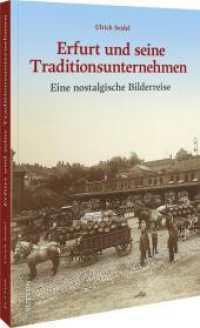Full Description
Methods of Research on Human Development and Families is an introduction to quantitative and qualitative research methods that teaches students how to be intelligent and critical consumers of research on families. This new book has been adapted from the author team's previous SAGE text, Methods of Family Research, and includes applications and examples from both family science and human development research. With a focus on interpreting and understanding research techniques rather than doing research, this text illustrates how research on families is conducted and helps students gain the competence and confidence to effectively read, interpret, and critique published research reports.
Contents
Preface
The Goal of This Text
To the Student
To the Instructor
Organization of This Text
Acknowledgments
About the Authors
Chapter 1 Why Do Research on Families and Children?
What Are the Stages of Social Research?
How Is Research on Families and Children Different?
The Benefits of Well-Conducted Research
Study Questions
Chapter 2 The Ethics of Research on Families and Children
The Rights of Participants in Research on Families and Children
What Is the Role of the Institutional Review Board?
Fraud in Research on Families and Children
The Value of Ethically Sound Research
Study Questions
Chapter 3 Causal Inference in Research on Families and Children
Variables
Units of Analysis
Thinking Causally
Framing the Hypothesis
Causal Inference in Qualitative Research
Study Questions
Chapter 4 Searching and Reading the Literature
Reading a Journal Article
Where Do I Go From Here?
How Do Journal Articles Get Published?
Research Monographs
Edited Volumes
Other Types of Publications
Study Questions
Chapter 5 Sampling Issues
Defining the Population
Sampling Designs
How Large Does the Sample Need to Be?
How Do We Go About Choosing a Sampling Technique?
Study Questions
Chapter 6 How Do We Measure Concepts?
Characteristics of a Good Measurement Procedure
Levels of Measurement
What Are Reliability and Validity?
Some Thoughts on Reliability and Validity
Study Questions
Chapter 7 Working With Scales and Indices
Types of Scales and Indices
Using Existing Scales and Indices
How Do We Evaluate Scales and Indices?
How Do We Deal With Missing Data in Scales and Indices?
Study Questions
Chapter 8 Studying Families: Methods for Quantitative Data
Studying Families Through Experiments
Studying Families Through Survey Methods
Studying Families and Children Through Nonreactive Techniques
Types of Nonreactive Research
"Big Data" in the Study of Families and Children
Secondary Analysis of Sample Surveys
Ethics and Quantitative Methods
Some Limitations of Quantitative Methods
Study Questions
Chapter 9 Studying Families: Methods for Qualitative Data
Qualitative Research Compared to Quantitative Research
Types of Qualitative Strategies
Studying Families Through Observation
Ethics and Qualitative Research
Evaluating Qualitative Research
Study Questions
Chapter 10 Studying Families: Mixed Methods
Mixed-Method Approaches to Family Research
Mixed-Model Studies in Family Research
Some Closing Thoughts on Choosing a Research Strategy
Study Questions
Chapter 11 Using Other People's Data
Advantages and Disadvantages of Secondary Analysis
Data on Children
Data on Adolescents
Data on Older Adults
Data on Families and Households
Sources of Secondary Data Sets
Future Trends in Secondary Data Analysis
Study Questions
Chapter 12 Analyzing Data on Families and Children
Descriptive Statistics
Interpreting Cross-Classification Tables
Inferential Statistics
Commonly Reported Tests of Statistical Significance
Some Thoughts About Statistical Analysis
Study Questions
Chapter 13 Advanced Topics in Family Data Analysis
The Idea of Nested Entities
Analyzing Nested Data
Individual Change Over Time
Final Thoughts on Nested Entities
Study Questions
Chapter 14 Evaluating Programs in Human Development and Family Science
Needs and Social Impact Assessment: What Is the Problem?
Outcome Assessment: Does It Work?
Process Research: How Does It Work?
Some Thoughts About Randomization in Evaluation Research
The Relationship Between Applied and Basic Research
Study Questions
Chapter 15 Politics of Research on Families and Children
Political Concerns in Research on Families and Children
Some Closing Thoughts
Glossary
References
Index








